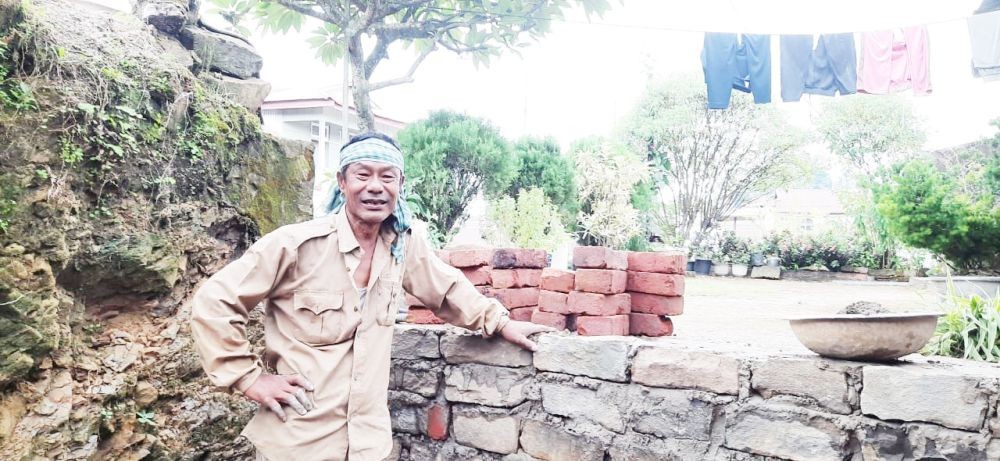Kikumsang Longkumer takes a break to smile for the camera at his work site in Ungma village, Mokokchung. (Morung Photo)

Limasenla Jamir
Mokokchung | September 25
Kikumsang Longkumer is a construction worker hailing from Ungma village and works as a ‘head mistry (foreman).’ He is referred to as Akumba by those who know him. In the early 1980s, Akumba enlisted in the Nagaland Police, but came back home after a year of training and never went back. Instead, he started working as a ‘jugali’ to earn his daily wage. He was 25 years then.
At 60 years now, Akumba is a sought-after head mistry in Ungma village who specialises in the construction of retaining walls made of carved rocks and bricks, the building of wooden and concrete homes, and other building-related tasks.
Akumba's talent and skills, according to him, are innate. He was born to a father who was an expert in making wooden furniture and handicrafts.
When he started working as a jugali, he used to earn a measly one hundred and fifty rupees per day. He now makes up to eight hundred rupees a day as the head mistry. “I was a jugali for 4-5 years, learning the trade from other elder mistries before rising to the position of a head mistry. I am training two to three jugalis who work with me to become head mistries like me,” he claimed.
“Working in the construction industry is all about hard work and skills. You cannot become a mason, a carpenter, or an electrician if you are lazy. Even if you have the skills, if you do not work hard, you do not earn,” Akumba said.
With the increase in the number of concrete houses, Akumba says that he is never at rest. Unless he is seriously ill or unless there are deaths and weddings in the village, he is occupied for at least twenty days a month. “I have even been to Dimapur and Kohima to construct retaining walls. I am also called to many of the neighbouring villages to build houses and construct walls,” he stated.
When discussing the options and skills between a local mistry like him and a non-Naga mistry by the people Akumba stated that he learned his skills by observing and assisting his father and other head mistries. He continued by saying that people in the villages naturally possess the traditional and indigenous skills and knowledge needed to build houses.
He claimed that many people choose to work with non-Naga mistry because they have no social duties and work even seven days a week including Sundays. “Villagers like us must stop working and attend all events if there are marriages or the deaths of family members, friends, or neighbours. However, it is not the case for the non-Nagas from outside the state. People also frequently compare the estimations of local and non-Naga mistries, but I think they are all equivalent because none of us has any engineering education or training. All of us are employing the skills we have developed through experience, with some coming from our parents and grandparents,” he stated.
With the job of a head mistry, Akumba has been able to raise three children. His wife would cultivate their jhum field and he would work as a mistry and on days when he does not get any work, he would help his wife in the field. As the demand for his work increased and as the wages increased steadily, he and his wife stopped cultivating and it has been few years now since they have stopped cultivating.
The past few years have been difficult for Akumba due to the pandemic and due to his age. “I am more prone to illness and weakness these days. Maybe it is because I am getting older and my job is wearing down my body,” he continued.
Even while he bemoans his frailty, he acknowledges that he is unable to stay home and do nothing. Akumba is currently supervising and working as a head mistry in the construction of a water tank in the village although he had not been in the best of health for almost two weeks.
Akumba has helped dropouts in the village by hiring them as his helper and training them at work. He has helped build many houses and construct numerous walls. His skills have only improved in his 35 years of experience as a head mistry.
“Oko Akumba does his work very meticulously and with so much dedication. I am acquainted with him as a relative, so we have always hired him for any construction work at home. He helped us in building our wooden home way back in the 90’s and we hired him again as the head mistry to construct our concrete building a few years back,” stated Aienla Aier, a relative and a regular hirer of Akumba, from Mokokchung Town.
“We all need to work to support our families, and when we do work, we must put in all our efforts and give our best. A lazy person will never be able to work in the construction industry, as I previously stated. We need to honour people employed in the construction sector and give their job the respect it deserves because they are the hardest-working individuals you will ever meet,” Akumba said.
This is the first of a five part series highlighting the experiences and challenges faced by the construction industry in Nagaland, as part of the Kohima Press Club and Nagaland Building and Other Construction Workers Welfare Board Media Fellowship.






